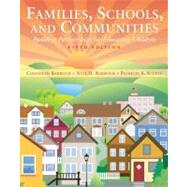This fifth edition of Families, Schools, and Communities: Building Partnerships for Educating Children provides teachers and teacher candidates with a comprehensive guide to establishing collaboration with parents and the larger community. This text will help future teachers develop the understanding and tools they need to work with others to give children a better education. The underlying message of this book is that all persons involved in early childhood education or child advocacy should join hands in promoting the highest quality of education for young children in America.
Features include:
-Chapter Objectives, Summaries and Questions
-Vignettes real life stories events that clarify the concepts throughout the chapters.
-Reflections these reflections ask the reader to pause and connect some particular content to their own life experiences.
-Implications for Teachers new feature that provides connections between the ideas in the text and real life application in classrooms and schools.
-Bibliography of Children's Literature
New to This Edition:
The authors have added features and rearranged the topics to give this text better coherence and greater usability. Readers will find we have updated references and resources throughout but have streamlined the research citations to provide for smoother reading. We removed the chapter on school curriculum but included suitable parts of that in other chapters. We have renamed some chapters to reflect changes in content, and we have grouped References by each chapter.
-New Figures and Tables throughout the chapters update data on demographics of American families and communities.
-New vignettes and illustrations to help readers understand the uniqueness of family life and the diversity in our country.
-Implications for Teachers featured in each chapter give readers practical suggestions for trying out the ideas in the real world.
-The Special Needs area is addressed more intensely by showing readers how to work with families of children with disabilities.
-Family Systems Theory is highlighted to show the importance of understanding total family functioning in addition to the differences of individuals.
-Protecting children has a higher profile. Authors include more information on the growing problems and concerns about obesity, bullying, substance and sexual abuse and help readers fit these concerns into the role of education.
-Media pluses and minuses are highlighted in our chapters so readers understand when the benefits of expanded media opportunities can shift to exploitation and abuse.








